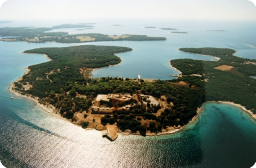

Brioni National Park
Brioni National Park  Safari park
Safari park
On the northern edge of Veli Brijun, in an enclosed area stretching over 9 hectares, lies the safari park that was established in 1978. The park is the habitat of many exotic animals: the Indian elephants Sony and Lanka; llamas - South American camel-like animals, which according to an Indian legend were domesticated at the very beginning of human existence; zebras; nilgai and kob antelopes; Somali sheep; Indian holy cows and autochthonous donkeys.
The nilgai or blue antelope were a gift from India from Nehru in 1959.
Very often the main features of antelope can be described in three words: fast, timid and graceful. In Africa, they are known to be as fast as the wind, yet as uncatchable as a dream. Their big eyes and long eyelashes radiate meekness, timidity and fear of their enemy. Although their place of origin is Asia, today they are found all over Africa: in the plains and savannas, jungles and river valleys, even mountains. The Arab name antelope means "floral eye". The strong blue antelope is the only representative of large antelope in South Asia. Originally, this is an Indian antelope named after the bluish-grey, almost dark blue colour of the males. They live in small herds. When fighting, the males get down on their front legs. Females bear 1 or 2 young a year.
Kob or marsh antelope (waterbuck) were a gift from Zambia in 1962 from Kenneth Kaunda. This is an African antelope. Both the males and females are tawny. Males have characteristic long pointed horns that can be 70 cm long, but the feature that makes them particularly graceful is the elevated hind part of the body in comparison with the front. In its natural habitat, this antelope lives in herds of 20-40, males and females together. Females begin breeding in their second or third year and bear 1 young at a time.
Somali sheep were a gift from Ethiopia in 1959. They originate from Asia, but are widespread in South Europe, Africa and North America. Each mountain range in Asia has one or two specific sheep species, which is how the Somali sheep evolved. They are usually dark coloured, with dark brown being the dominant colour. Males have long hair under their neck, strong necks and horns curved downwards, whereas females have little horns and short hair. They live in large flocks and bear one, or less frequently two, young at a time.
Since animals live freely in the safari park, their life together has resulted in Brionko, born 5 March 2003, a crossbreed between a Somali sheep and mouflon. This lovely animal is probably the only example developed by crossbreeding Somali sheep with mouflon.
The Llama is a South American member of the camel family, differing from the common camel because of its smaller body and relatively large, narrower head with pointed snout, large eyes and slender legs, with two toes that are set apart. Llamas have no hump and are covered with long, thick woolly hair. They live in the high plains of the Cordilleras up to 4,500 metres above sea level. Since ancient times, Indians have used the hair of the llama to make blankets and garments.
Steppe and mountain zebras (Equus quagga and Equus zebra) were received as a gift from Guinea in 1960 and 1961 from Seku Ture. An ancient Roman writer told stories about the Roman emperor Caracalla who in AD 211, besides tigers, elephants and rhinoceroses also sent a "striped horse" (hipotigris) into the arena and killed it with his own hands. The writer was surely referring to the zebra.
Mountain zebras show more resemblance to a donkey than a horse, and live in the mountainous regions of southern and eastern Africa. They usually live in large herds together with antelopes, giraffes and ostriches. The lion, as the zebra's chief foe, fears its small, yet extremely hard hoof. All attempts to tame zebras and train them to work as domestic animals have failed. Zoologists still have different theories of whether their colour pattern protects them by allowing them to blend in with the surroundings or not.
Zebu or Indian holy cattle (Bos indicus), a gift from India presented by Nehru in 1959. The small holy cattle are in fact a dwarfish species of Indian holy cows. They share all the features of cattle, but are smaller in size and not as heavy. Fully-grown bulls are dark brown with strong, yet short horns. They also have a distinctive hump for storing extra food. Bulls weigh up to 300 kg, whereas cows weigh up to 150 kg and bear one calf at a time.
Elephants - Brijuni's Indian elephants (Elephans maximus) were gifts from India, received in 1972 and 1974. The first elephant, a gift from Guinea in 1961, died. Elephants are up to 3 metres tall and weigh 4-5 tons. They live in the jungles of India, Sri Lanka, Borneo and Sumatra. Male elephants can weigh up to 6 tons, which makes them the largest living mammals. Despite its huge size, the elephant has a light and barely audible gait since each foot has a thick pad of elastic tissue that acts as a cushion. An elephant touches, smells and breathes with its trunk, and even uses it to make sounds. It eats at least 80 kg of food a day and its trunk can suck in 6-10 litres of water, so that it drinks up to 200 litres of water a day.
Donkeys (Roko and Bero) were owned by the poor and were used exclusively for carrying loads and sometimes for hauling. They have become an endangered species in our country. In the safari park, there is an example of both the Istrian and Dalmatian donkey, which have become an attraction.
Izvor: http://www.brijuni.hr/
Video
Current news
 Macrocruise charter agency
Additional discount on the boat rental price of betw
Macrocruise charter agency
Additional discount on the boat rental price of betw





























